

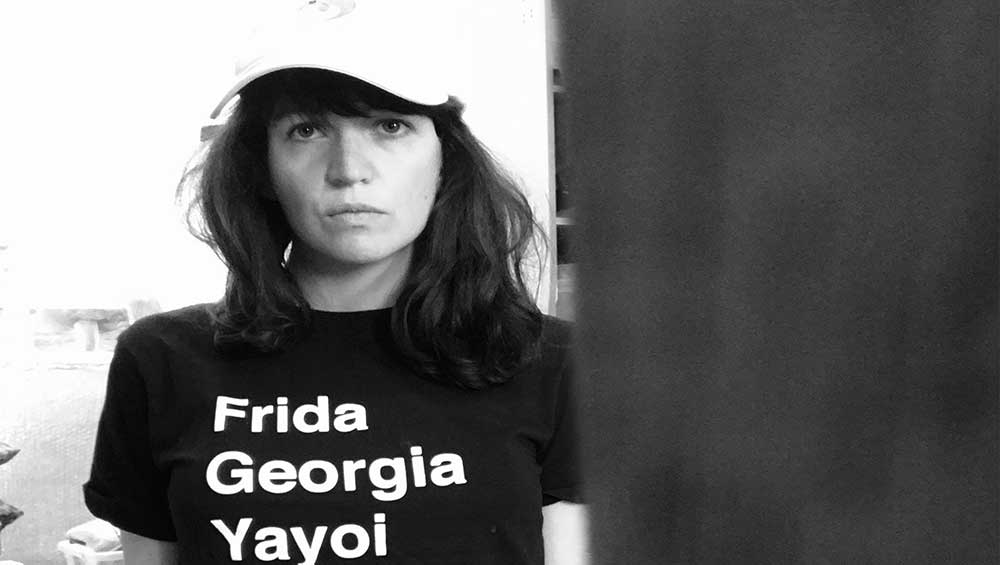
Nika Neelova portrait. © the artist.
by VERONICA SIMPSON
Nika Neelova (b1987, Moscow) has a gift for translation, for mining new perspectives from old or familiar materials and contexts. Working exclusively with found objects or materials, this talent for examining and re-presenting everyday stuff from a multitude of angles – including the object’s tactility, substance or origins, its place in the landscape, its interdependence with humans, its role in architecture or archaeology, or all the above – may well have its origins in her peripatetic upbringing.
She was a child when her parents moved from Moscow to Paris, where she became fluent in French in addition to her native Russian. She returned to Moscow in her early teens before starting fine art studies at the age of 16 at the Royal Academy in The Hague, where she had to learn Dutch from scratch. Graduating with a BA in 2008, she then plunged into a new culture and language, moving to London to do an MA in sculpture at the Slade School of Art, which she completed 2011. London has remained her home since.
“The upside of moving a lot is you never live within one language,” she says. “It’s being constantly translated into a different language, so you need to adapt … I really struggle to think in one specific language because I’m always translating in my mind. Put into a French school straight away with zero French, from Russia, I felt somehow redacted, without the use of verbal communication, so I started making these pathways within my mind in order to exist within different linguistic capabilities.”
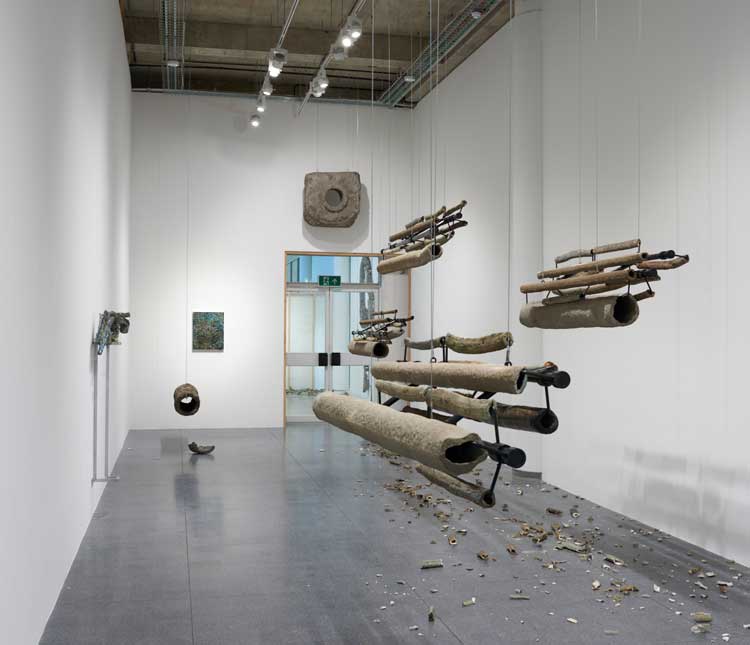
Nika Neelova, Silt, installation view, Brighton Centre for Contemporary Art, 2021. Photo: Jonathan Bassett, courtesy of Brighton CCA.
Her current solo show at Brighton CCA is a case in point. Silt is the subject - the noun - but it is also the object and the verb. Pipes are suspended on hanging structures, but these pipes are silted structures, formed and moulded out of real pipes. Through combining the existing layers of silt and sediment with various setting elements, Neelova reveals the action of water moving through pipes over time, showing the transition of this vital, granular substance through our landscapes, our cities and our lives.
Equally, the handrail sculptures that she has placed around her current show at the New Art Centre in Salisbury are both humble objects – they comprise repurposed wooden handrails she has salvaged from house demolitions – and relics of home and comfort, the means by which humans are moved through space, the conduit for passages between levels, carrying the traces of all those human hands that have touched them.
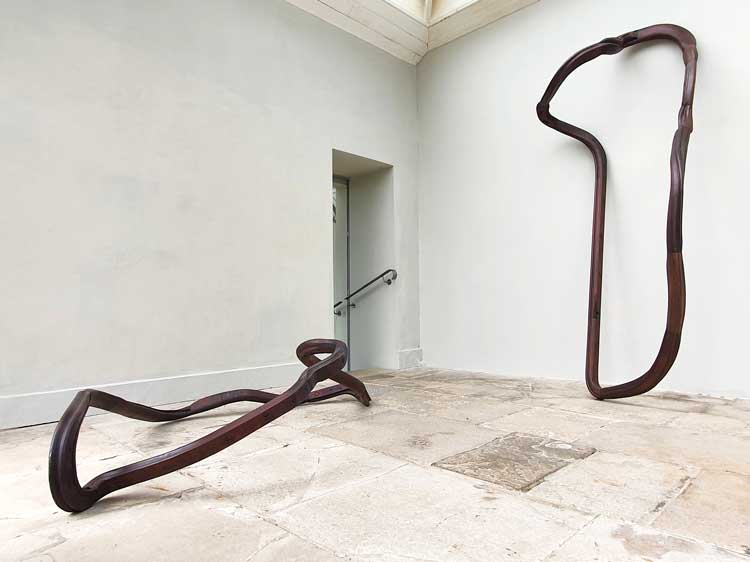
Nika Neelova. Left: Lemniscate X, 2020. Hardwood reclaimed handrails, two flights of stairs, 50 x 210 x 120 cm. Right: Lemniscate XI/II, 2021. Hardwood reclaimed handrails, two flights of stairs, 280 x 130 x 60 cm. Installation view, One of Many Fragments, New Art Centre, Roche Court, Salisbury 2021.
Recognition for her work came early. She was awarded the Kenneth Armitage Young Sculptor prize and the Saatchi New Sensations prize in 2010, the Land Security Prize in 2011, the Royal British Society of Sculptors Bursary in 2013, and a syllabus residency at Wysing Arts Centre in 2017. She has appeared in several group shows, and in 2019 had two solo exhibitions – Glyphs, curated by Domenico de Chirico, in Turin, and Ever, at the Tetley, Leeds. She finishes 2021 with a flurry of shows. The foremost of these is the aforementioned Silt, the culmination of a lengthy artist residency, at Brighton Centre for Contemporary Art (CCA). She shares the bill with her former Slade tutor Edward Allington in One of Many Fragments at the New Art Centre, Roche Court, and is exhibiting at the Copperfield Gallery in London and the Garage in Moscow. She is represented in London by the Vigo Gallery.
Studio International met her in London, at The School House cafe at Jerwood Arts.
Veronica Simpson: Tell us a little about your early art studies. I am intrigued by the fact that, having been so frequently transplanted from one culture and language to another as a child, you chose to study art first in the Netherlands and then London. What were the Dutch and UK art school experiences like, coming to these languages and cultures anew?
Nika Neelova: The Dutch art school system was challenging – you were left to your own devices. It was complete freedom after the strictness and dictatorial attitude of Russian education. I threw myself into it. It’s as if I was awakened. During these five years, I was absolutely fearless. It diminishes over time, of course. Now it’s really hard to recover this feeling of fearlessness.
Slade was completely different. It was very structured, very strict. It was disciplined and very British in some ways because there was a strong sense of hierarchy. Also, I was very young – 20 or 21 – when I did my MA. Everyone was a bit older than me and very well read, and I felt like I was constantly catching up.
VS: But clearly on some level you thrived.
NN: I think it was the insane challenge that it presented that awoke this hunger to persevere. And, in the end, it was a very good time. It turned me inside out. I took the hardest way I could find to break everything and start over. For my degree show, I burned everything I had made over the two years and then I made the installation out of what was left. It was just me walking around the Slade with a blow torch and burning stuff. And everybody couldn’t wait for me to graduate because I was like an absolute health and safety hazard. It was intense.
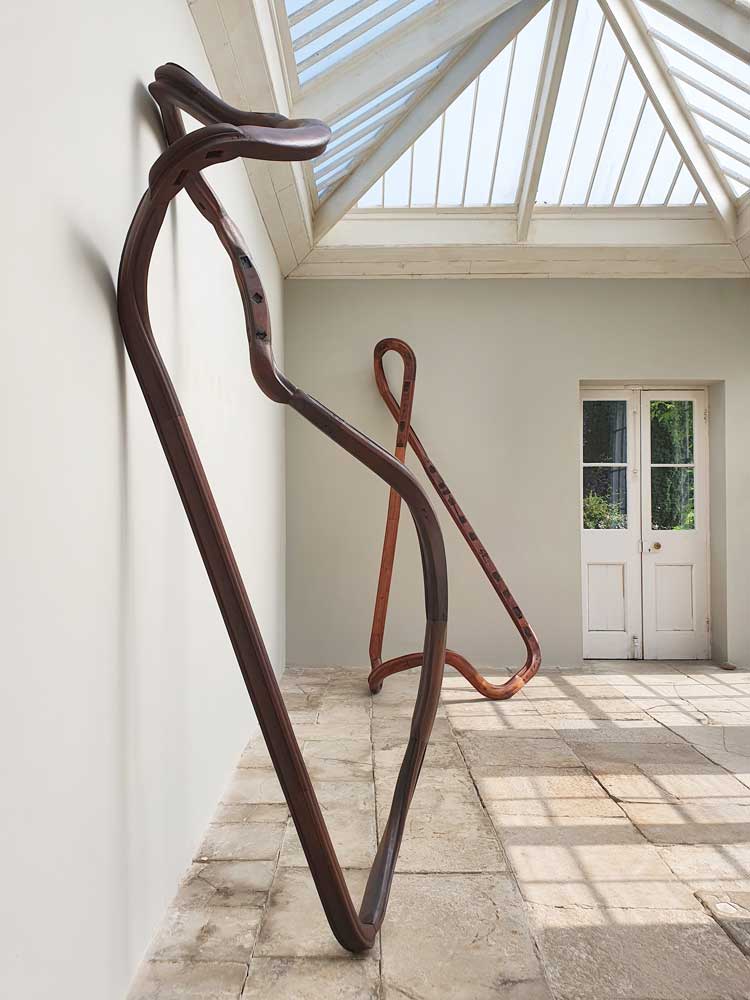
Nika Neelova. Foreground: Lemniscate XI/II, 2021. Hardwood reclaimed handrails, two flights of stairs, 280 x 130 x 60 cm. Background: Lemniscate IX, 2020. Hardwood reclaimed handrails, two flights of stairs, 310 x 130 x 70 cm. Installation view, One of Many Fragments, New Art Centre, Roche Court, Salisbury 2021.
VS: The work at the New Art Centre – beautiful sculptures made from repurposed wooden handrails - demonstrates a really interesting, layered conversation between body and architecture, which seems typical of the work you have been making in the decade since graduating. Yet with the new show in Brighton, Silt, you are still thinking about interactions with the human body, but within the context of the wider landscape, geological time, deep time.
NN: The work at the NAC represents a specific cycle. I worked a lot with the connection between the human body and the architecture of space. And the handrails were about the intimate contact of the palm of the hand and the architecture of space extruded over floors and flows. This idea of demolishing and recovering objects and extending their duration was very important to me. For a long period, I worked specifically with objects that are moulded around human proportions. Then the human is kind of removed and remains like a vestigial memory. The imprint, the traces, the spaces around the human body are absorbed by furniture, by architecture, the handrails get worn out in the places where they’re touched. It was very much about this flow of time through objects and duration of artefacts in relation to human lifetimes.
Right now, I’m starting to move to a deeper geological scale because it’s a way of extruding this intimate relationship between human and building to a relationship between human and building and earth. So, it’s about how humans leave their imprint on the earth through time. And Silt came very much from thinking about this. It’s still incredibly architectural. The large installation that’s suspended in the gallery uses casts from the sediment inside existing pipes - all the pipes that connect to various architectural bodies and water that flows through them connected with human bodies. And the sediment that clogs up these pipes, it comes from water that directly touched bodies – it was used for washing, it was used in houses, it was deposited over time. So, there is this sedimentation of time and again touch with humans, with the human being removed. And it’s unearthing this skeleton that contains all the remainders of human activity. And silt basically illustrates this idea because it’s a material that comes from erosion. It’s rocks that erode then become dust, then they are transported by water over huge geographical expanses and through time.
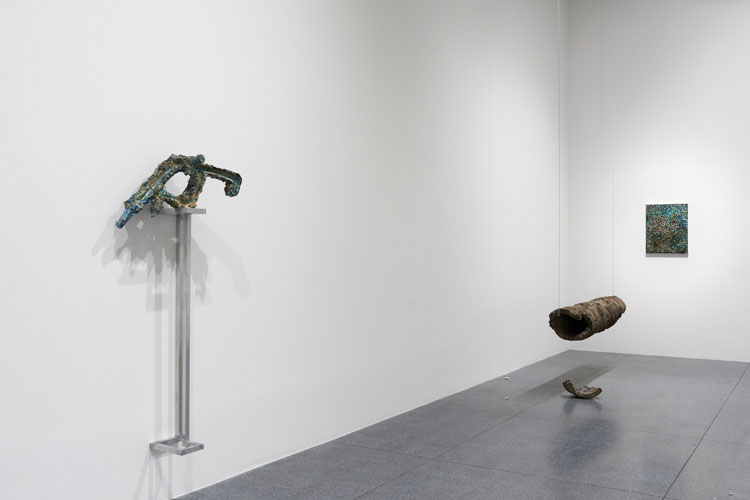
Nika Neelova, Silt, installation view, Brighton Centre for Contemporary Art, 2021. Photo: Jonathan Bassett, courtesy of Brighton CCA.
It’s a material of undoing and a material in constant flux. You can’t quite grasp it. It’s very granular. It’s constantly slipping through and picking things up along the way. It becomes part of the siltstone or sandstone. This is something I wanted to pick up on: that everything in the world around us is constantly undoing and you can just grasp a moment of it. That’s what silt meant for me (laughs).
VS: You had an extra year to think about this residency because of the pandemic. Did that allow you to enrich or expand your research or your process?
NN: Definitely, because it was a time of slowing down. Changing the pace of the work was very important because I felt at some point that I slowed down to geological time - when it moves really, really slowly and you are almost experiencing the movement of stones around you. I think the pandemic was this moment of hiatus where everything slowed around you. For me, it was a way to go deeper into this slower time … It was a way to zoom into the world like you could suddenly see it in much more detail and time was a longer expanse. I think that really dictated a lot of the things that I wanted to put into the show, this slow flux and slow undoing, and (the idea) that everything is about material exchange. Nothing is static. Everything is in a constant process of becoming something else.
VS: There were several different sources for these pipes which you used to cast the silt structures in, including, I believe, ancient Roman pipes?
NN: Yes, the large roundel sculpture (see below), is a replica of Roman pipes. I made it from recycled sculptures I’d previously made. It became an archaeological collage of putting times together that never coexisted, but you suddenly experience all these materials in one room.
03.jpg)
Nika Neelova, replica of Roman pipes, installation view, Silt, Brighton Centre for Contemporary Art, 2021. Photo: Jonathan Bassett, courtesy of Brighton CCA.
The installation begins with ancient Roman pipes and some of the suspended pipes are contemporary ones that I recovered from demolition sites around London. It’s this invisible narrative, a petrified narrative that allows the viewer to travel through a huge historical expanse of time in one room. I built it as if, in my mind, you are starting from underground and moving towards the surface and you … experience different layers of strata with different layers of fragments of ruins of existence and you are moving subtly through existence to the present day.
VS: This theme of translating materials through space, through time, through human encounter is so strong. I wonder if moving so many times in your life and having to translate yourself into each new environment gives you almost an extrasensory perception of the power of words, objects, images, the power of gestures, to say so much when you are struggling to express yourself in the most basic terms. It’s a portal into a different language of communication.
NN: Exactly, that’s why I’m so attracted to materials, to flows, to things that are adapting constantly, things that change themselves, things that are never static. And I always look up etymologies of words to find their origins. It’s fascinating how language mutates through so many different linguistic stages. There are incredible crossovers between so many languages. The word “silt” travels through old German through Norwegian and Danish in etymology and goes all the way to the English used in the middle ages, from the word salt. It mutates as well: it’s a hybrid word that has linguistically travelled through times, just like silt travels and gets entangled along the way. These flows are very similar. How a person lives through time, how a material develops, how words develop – I really enjoy trying to find this connection. An ability to speak many languages helps you see the world in a slightly more profound way… I really have to think about the definitions of words.
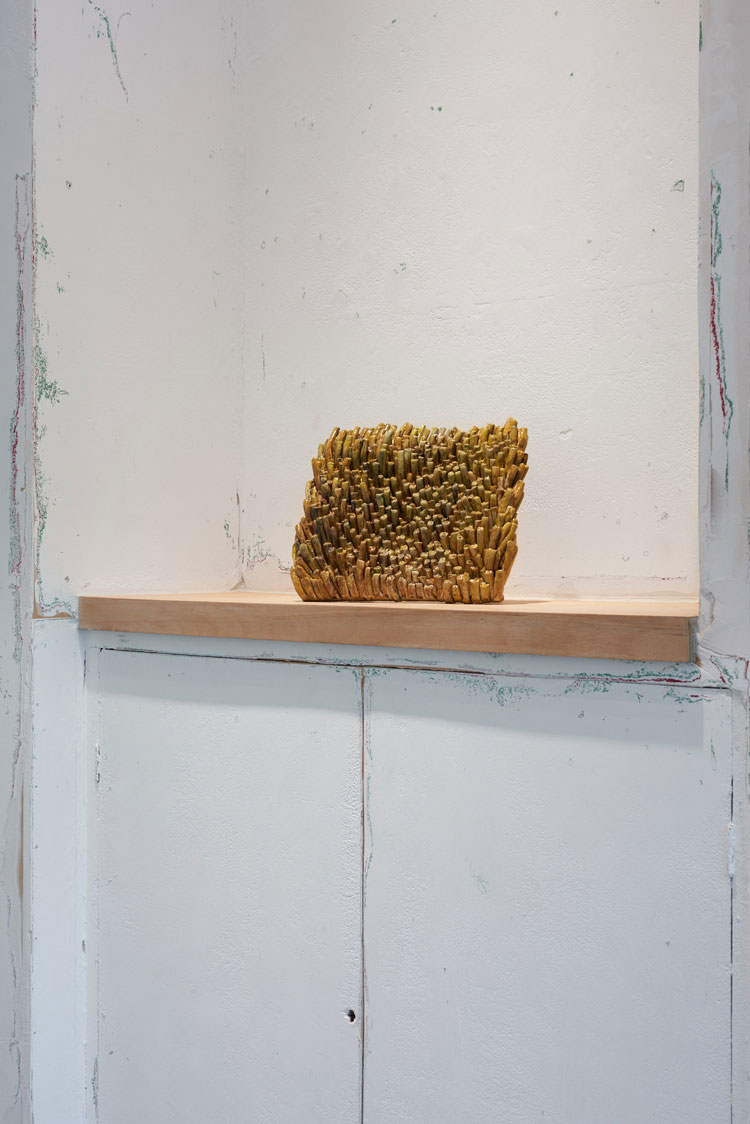
Nika Neelova, Silt, installation view, Brighton Centre for Contemporary Art, 2021. Photo: Jonathan Bassett, courtesy of Brighton CCA.
VS: Also, it gives you that sense of alternative realities through languages. We construct our languages to reflect a certain view of reality.
NN: Yes, and it’s much more visible when you’re outside this framework. I observed English language happening around me when I came to the Slade and I could not understand the British accent. It was fascinating trying to reconstruct what I thought was going on around me versus what was actually happening. You see different sides of the same object because you can approach it from all sides. I do enjoy having this reference in another language, which sounds and feels completely different.
VS: The original commission from Brighton CCA was to explore your thinking around water and silt, enriched by conversations with the scientists at Brighton University – especially geologists, ecologists and marine scientists. Did that happen, given the lockdowns?
NN: No. I mean, we started doing it just before the pandemic. I met with a few professors. But I was not really able to get involved in the science. I had a few Zoom calls with sedimentologists. It was helpful to have this academic backdrop, but it wasn’t possible to be part of the fabric of the university. But through Zoom and (Brighton CCA director) Ben Roberts’ ability to connect me with different departments, it was still very much possible. Every piece came through dialogue, which was a fascinating way of working and is far less isolated than the way I would normally work. Also, Ben involved the curator Sophie J Williamson, who is absolutely brilliant and one of the most fascinating minds. She has written a text to go with the exhibition. Having the initial conversation with her was incredible. The first time I met her on Zoom we were both reading Robert Macfarlane’s Underland. I think we were even on the same chapter. We were both excited by this avalanche of geological insights, which we’ve interpreted very differently, but it was such a fascinating conversation that it really helped the structure and direction of this show. I struggle to call it a show because it became this overarching project that has defined the interest I have with so many things: it seeped out of the boundaries of being just an exhibition. It continues in my mind.
VS: Another thing I like about this Brighton show is that you are showing the value of something that people perceive as having no value.
NN: We are also drawing a parallel between veins in the body, rivers in the earth and architectural pipework, it’s very repetitive in structuring, very similar in biology and geology and architecture. Bringing this parallel between the movement of fluids in the human being in relationship with fluids in the earth, so the nature culture divide can be abolished …
That’s one reason why I enjoy reading medieval philosophy so much, because there is not so much of a divide between sentient and non-sentient beings or human and non-human entities. Even stones have magical properties. Everything belongs to both worlds at the same time. With the Enlightenment, we lost this ability to be in a continuous world where there is this idea of continuum and everything merged and became part of the larger whole, which I find really attractive and relevant.
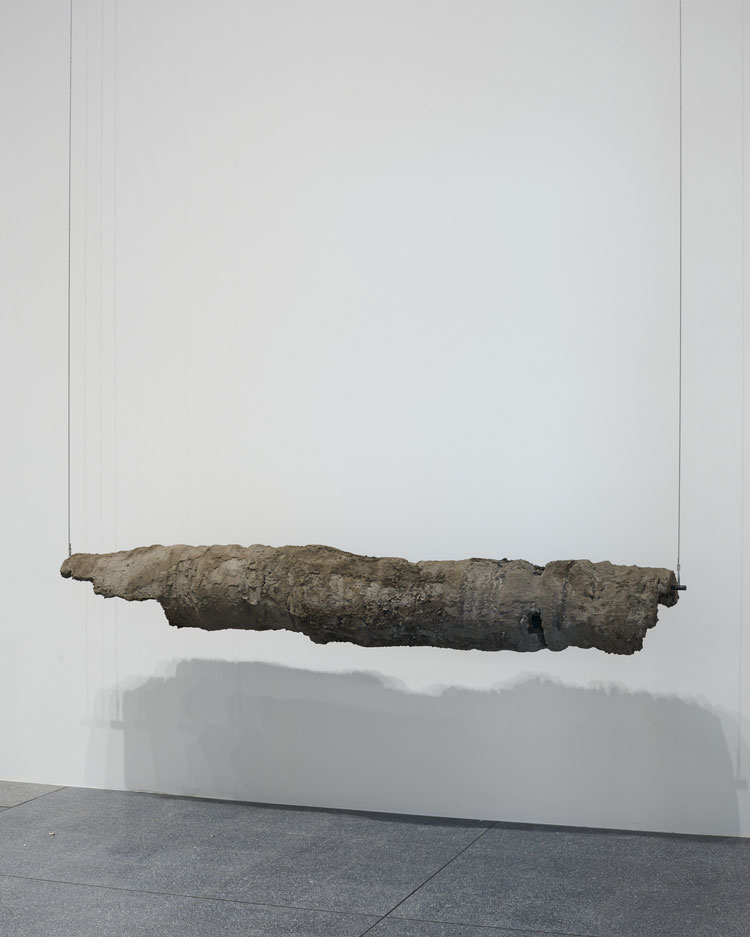
Nika Neelova, Silt, installation view, Brighton Centre for Contemporary Art, 2021. Photo: Jonathan Bassett, courtesy of Brighton CCA.
I do believe that matter has sentience because it is self-organising. There are molecules, and if you think about it, they have their consciousness. It is about finding different ways of being conscious which is not human consciousness. This translates into the way that I work. I never try to force things into configurations … It’s about how matter falls and gravity falls and all the imperfections of the surface. I try and leave them as they are because it’s part of how matter finds its place.
VS: This is important in your practice; that you are repurposing things that already exist.
NN: It’s not about modes of production. I never really produce things. It’s about finding modes of revealing and retrieving information that’s out there and that already exists. I never make things from scratch. Everything already exists and it’s about trying to put it in a different circuit, liberate it from its everyday meaning - the hierarchy of use, the purpose that is assigned to it - and putting it into another route to continue its existence outside the factors it was almost presupposed to serve.
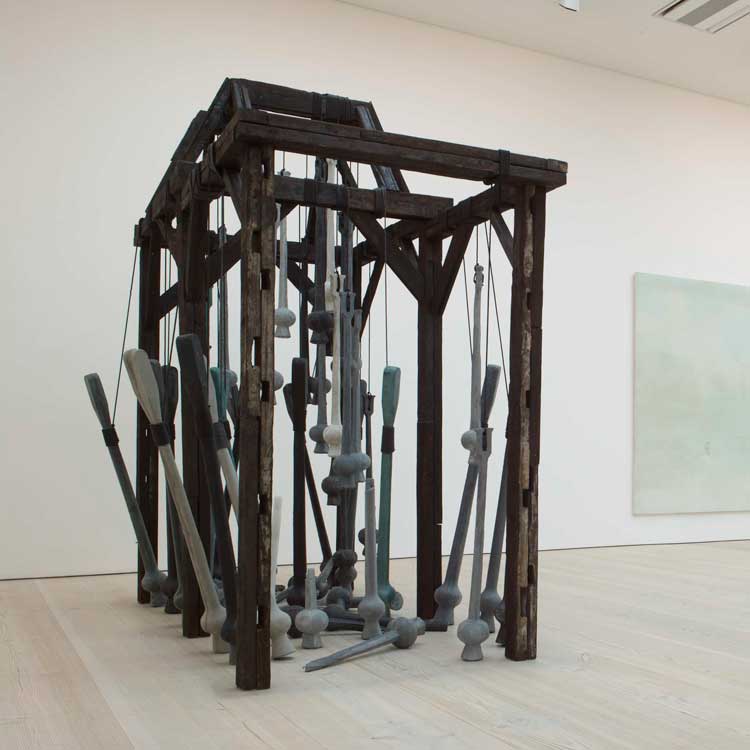
Nika Neelova, Principles of surrender, 2010. Burnt timber, bell clappers cast in wax infused with ash, rope, 250 x 150 x 300 cm. Photo copyright Stephen White.
VS: Speaking of which, I heard that you used casts of ancient bell clappers for the sculpture that you showed at Saatchi New Sensations (2010).
NN: Well, I borrowed the bell clappers from the Whitechapel Bell Foundry. It was the first piece I did after the Slade. I cast 30 of these bell clappers in wax or ashes and they were all suspended within this burnt-timber structure I created from (the relics of) my degree show, and I also used the ash from the stuff that I burned from the degree show to colour the bell clappers. They were suspended within this structure that was like the skeleton of a belfry. And something that is associated with sound became the image of silence. Many were broken on the floor, cast in wax, incredibly fragile and unable to fulfil their original purpose.
It’s now in the Saatchi Collection somewhere. It was also interesting because bells used to be the centre of communication, they held communities together, they were used to announce everything, so it was something quite integral and timeless.
• Edward Allington and Nika Neelova: One of Many Fragments is at New Art Centre, Roche Court, Salisbury, until 20 November 2021. Nika Neelova: Silt is at Brighton CCA until 22 December 2021. Neelova is also part of Not Painting, a group exhibition at the Cøpperfield Gallery in London, until 29 January 2022.